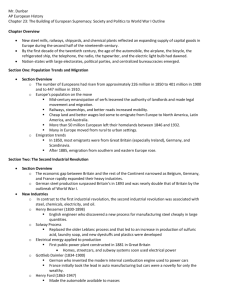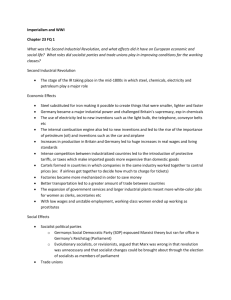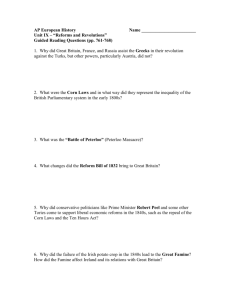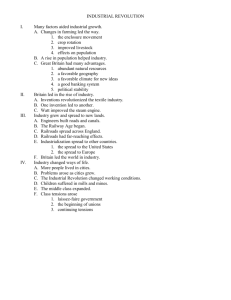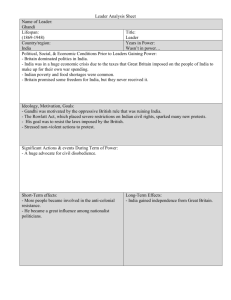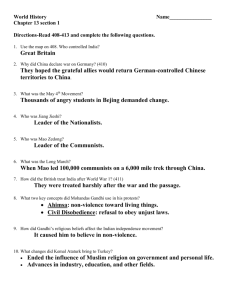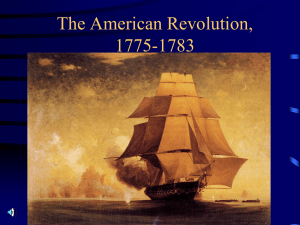Mr. Dunbar AP European History Chapter 23: The Building of
advertisement
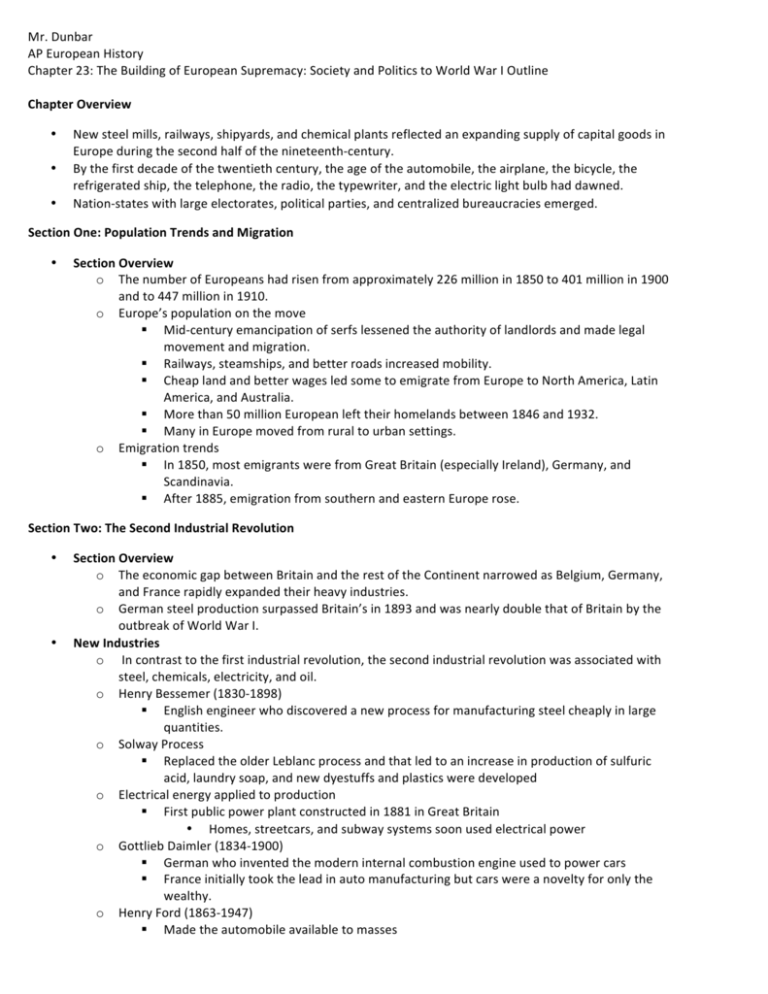
Mr. Dunbar AP European History Chapter 23: The Building of European Supremacy: Society and Politics to World War I Outline Chapter Overview • • • New steel mills, railways, shipyards, and chemical plants reflected an expanding supply of capital goods in Europe during the second half of the nineteenth-­‐century. By the first decade of the twentieth century, the age of the automobile, the airplane, the bicycle, the refrigerated ship, the telephone, the radio, the typewriter, and the electric light bulb had dawned. Nation-­‐states with large electorates, political parties, and centralized bureaucracies emerged. Section One: Population Trends and Migration • Section Overview o The number of Europeans had risen from approximately 226 million in 1850 to 401 million in 1900 and to 447 million in 1910. o Europe’s population on the move ! Mid-­‐century emancipation of serfs lessened the authority of landlords and made legal movement and migration. ! Railways, steamships, and better roads increased mobility. ! Cheap land and better wages led some to emigrate from Europe to North America, Latin America, and Australia. ! More than 50 million European left their homelands between 1846 and 1932. ! Many in Europe moved from rural to urban settings. o Emigration trends ! In 1850, most emigrants were from Great Britain (especially Ireland), Germany, and Scandinavia. ! After 1885, emigration from southern and eastern Europe rose. Section Two: The Second Industrial Revolution • • Section Overview o The economic gap between Britain and the rest of the Continent narrowed as Belgium, Germany, and France rapidly expanded their heavy industries. o German steel production surpassed Britain’s in 1893 and was nearly double that of Britain by the outbreak of World War I. New Industries o In contrast to the first industrial revolution, the second industrial revolution was associated with steel, chemicals, electricity, and oil. o Henry Bessemer (1830-­‐1898) ! English engineer who discovered a new process for manufacturing steel cheaply in large quantities. o Solway Process ! Replaced the older Leblanc process and that led to an increase in production of sulfuric acid, laundry soap, and new dyestuffs and plastics were developed o Electrical energy applied to production ! First public power plant constructed in 1881 in Great Britain • Homes, streetcars, and subway systems soon used electrical power o Gottlieb Daimler (1834-­‐1900) ! German who invented the modern internal combustion engine used to power cars ! France initially took the lead in auto manufacturing but cars were a novelty for only the wealthy. o Henry Ford (1863-­‐1947) ! Made the automobile available to masses Economic Difficulties o Second half of the nineteenth century ! 1850-­‐1873 both industry and agriculture prospered ! 1873-­‐1900 both slowed • Strikes were common during this era • Economic downturn fed the growth of socialist political parties o Problems for European agricultural products ! European foodstuffs were in competition with products from all over the world now that transportation and refrigeration had improved. o Several European banks failed in 1873 and the rate of capital investment slowed. o Consumerism and economic recovery by 1900 ! As the economy strengthened and urbanization increased, demand rose for consumer products. ! New forms of retailing—like department stores, chain malls, and mail order catalogs appeared Section Three: The Middle Classes in Ascendancy • Social Distinctions within the Middle Class o Most prosperous members lived in splendor that rivaled the lifestyle of the aristocracy ! For example W.H. Smith, the owner of railway newsstands, was made a member of the House of Lords. o Comfortable, small entrepreneurs and professional people ! Capable of owning private homes, large quantities of furniture, pianos, pictures, books, journals, education for their children, and vacations ! Usually educated ! Also included shopkeepers, schoolteachers, librarians, and others who had skills derived from education o “White –collar workers” (also called the lower middle class, or petite bourgeoisie) ! Secretaries, retail workers, lower level bureaucrats in business and government. o Tension existed among different groups in the middle class Section Four: Late-­‐Nineteenth-­‐Century Urban Life • Section Overview o Urbanization ! 1850-­‐1911, urban dwellers rose from 25 to 44 percent of the population in France and from 30 to 60 percent of the population of Germany o Unrest common among different ethnic groups—like Russian Jews—who were uprooted and moved to the cities of Western Europe. • The Redesign of Cities o Restructuring of Europe’s cities ! Government s stepped in and redesigned centers of cities to be areas where businesses, government offices, large stores, and theaters were located. o The New Paris ! City that was most transformed during this period ! Napoleon III hired Baron Georges Haussmann to oversee the reconstruction of Paris • The news Paris included wide roads, and many of the narrow alleyways were destroyed, so insurrections could be quickly squashed by the government. ! Creation of many public buildings and gardens like the Paris Opera and the Bois de Boulogne were constructed. ! Started to build a subway station in 1895 ! Eiffel Tower was built in 1889 o Development of Suburbs • Urban land value and rent went up due to commercial development, railway construction, and slum clearance. ! Middle classes looked for neighborhoods removed from urban congestion and, consequently, suburbs develop. ! Railways, subways, and electric tramcars connected middle class workers to their employment in cities and home and work became more separate than ever before. • Urban Sanitation o Importance of sanitation to social and political stability ! it was widely believed that only when the health and housing of the working class were improved would middle-­‐class health also be secure and the political order stable o Impact of Cholera ! Epidemics in the 1830s and 1840s led to growing concern for sanitation in urban areas. ! Mid-­‐nineteenth century science taught that miasmas in the air spread infection that lead to cholera and other diseases, and miasmas, which could be detected by their foul odors, were believed to arise from filth. ! Scholars in England, France, and Germany encouraged governments to launch city clean-­‐up programs. • Louis Rene Villerme (1782-­‐1863) in France • Edwin Chadwick (1800-­‐1890) in England • Rudolf Virchow (1821-­‐1902) in Germany o New Water and Sewer Systems ! Greatest health and engineering achievements of the second half of the nineteenth century. ! Wherever facilities systems were installed, the mortality rate dropped considerably. o Expanded Government Involvement in Public Health ! In Britain the Public Health Act of 1848, in France the Melun Act of 1851, and various laws in the German states allowed government inspectors to enter private homes in the name of public health. ! Medical breakthroughs near the close of the century • Louis Pasteur (1822-­‐1895) in France, Robert Koch (1843-­‐1910) in Germany, and Joseph Lister (1827-­‐1912) in Britain, increased concerns about cleanliness. • Housing Reform and Middle-­‐Class Values o After the revolutions of 1848, the overcrowding in housing and the social discontent that it generated were also seen to pose political danger. o A.V. Huber ! Early German housing reformer who believed that providing decent housing to the poor would foster a good home life, in turn leading to a healthy, moral, and politically stable population. o Jules Simon (1814-­‐1896) ! French housing reformer who saw good housing as leading to good family life and, ultimately, to strong patriotic feeling o Programs and legislation were enacted to lower interest rates to construct cheap housing. Section Five: Varieties of Late-­‐Nineteenth-­‐Century Women’s Experiences • Section Overview o Generally speaking, women remained economically dependent and legally inferior to men regardless of social class. • Women’s Social Disabilities o Women and Property ! Until the last quarter of the nineteenth century, married women could not own property in their own names. ! Reform of women’s property rights came slowly ! • • • Family Law ! Legal codes required women to “give obedience” to their husbands. ! Tradition of Roman Law and the Napoleonic Code made women legal minors throughout Europe. ! Divorce • Divorce was difficult everywhere in Europe • “cruelty” or “injury” were grounds for divorce • In Britain, adultery was a common reason for divorce. • Husbands’ extramarital sexual relations were tolerated to a much greater degree than those of wives. ! Husband’s rights over children • Could take children away from mother and have child reared by someone else • Only a father could permit his daughter to marry • In case of divorce, husband was usually given custody of children o Educational Barriers ! Most universities were not open to women until the last quarter of the nineteenth century. • University of Zurich opened to women in 1860. • University of London did in 1878 • Oxford in 1920 and Cambridge in 1921 women were permitted to earn degrees • Austrian universities admitted women just before the turn of the century. • Prussian universities didn’t admit women until after 1900. • Russian women did not attend universities until 1914. ! The absence of secondary schools for women prevented them from learning the skills necessary to succeed at the university level. ! Women found a haven in as school teachers in the elementary schools sprouting up throughout the continent. New Employment Patterns for Women o Section Overview ! Second Industrial Revolution impacted women employment in two major ways • large-­‐scale job expansion in the variety of jobs available to women outside the better paying learned professions • withdraw of many married women from the workforce o Availability of New Jobs ! Women worked in jobs that required little skill • Expansion of government bureaucracies, the emergence of corporations, and the vast growth of retail stores created many employment opportunities for women • Education laws making elementary school mandatory triggered a need for school teachers. • Women became secretaries and clerks. ! Women were paid lower wages as it was assumed that they could rely on the financial support of their husbands or fathers. o Withdrawal from the Labor Force ! Married women—especially after the birth of the first child—withdrew from the workforce. ! Limited work in the textile industry for women ! Decline in number of children being born • Employers preferred women whose family lives would not interfere with their work • Not as many women were needed to look after the children of other women. ! Male wages increased during this period. ! Men lived longer than before and widowed women were not as commonly forced to find work, o • Married Woman’s Property Act (1882) in Britain permitted married women to own property. In France, a married woman could not even open a savings account until 1895 and did not earn possession of the wages they earned until 1907. By 1900, in Germany, a woman could get a job without permission but her wages were turned over to her husband. Social dominance of the middle class established social expectations that a married women should not work. Working-­‐Class Women o Textile industry still employed many women ! German textile industry • Putting out system o Manufacturers purchased material and then “put it out” to several tailors in small shops or in their homes who made finished products. ! Working women were often exploited because their wages were often regarded as supplementing those of their husbands. Poverty and Prostitution o Since there were always more women searching for jobs than there were jobs available, thousands of women worked as prostitutes. ! On the Continent, prostitution was legalized and subject to governmental regulations. ! Recent scholarship shows that women were usually active as prostitutes only for a few years, usually late-­‐teens to mid-­‐twenties ! The customers of poor working-­‐class prostitutes were primarily working-­‐class men. Women of the Middle Class o Section Overview ! Consumerism involving the purchase of goods for domestic comfort occupied many middle-­‐class women. ! Middle-­‐class households had domestic servants o The Cult of Domesticity ! Pros and cons of domestic life • While middle-­‐class women might enjoy great luxury and comfort, but their lives, talents, ambitions, and opportunities for applying their intelligence were sharply circumscribed. ! The home came to be seen as the center of virtue, children, and the respectable life. ! Romantic marriage came to be seen as dangerous to social stability and, therefore, people continued to marry for economic reasons. o Religious and Charitable Activities ! Women were expected to frequently appear at mass and insure the religious instruction and religious life of the family. ! Middle-­‐class women often led charities and other programs. o Sexuality and Family Size ! Diaries, letters, and even surveys indicate that sexual enjoyment rather than sexual repression was fundamental to middle-­‐class marriages. ! Average middle-­‐class family size dropped as the cost of childrearing increased. The Rise of Political Feminism o Obstacles to Achieving Equality ! Many women were reluctant to support feminists causes ! It was difficult for working-­‐class and middle-­‐class women to cooperate ! Women often had trouble agreeing on the goals of the movement ! The argument for utility and efficiency could be used to expose the human and social waste implicit in the inferior role assigned to women o Votes for Women in Britain ! Britain boasted Europe’s most advanced women’s movement. ! Millicent Fawcett (1847-­‐1929) led the moderate National Union of Women’s Suffrage Socieites. ! Emmeline Pankhurst (1858-­‐1928) led a more radical branch of feminists • She founded the Women’s Social and Political Union • Followers known as suffragettes lobbied for women’s right to vote • When the government failed to reform policies toward women, the group resorted to violent tactics of arson, breaking windows, and the sabotage of postal boxes. ! Only in 1918, as a result of their contribution to the war effort, did women in Britain gain the right to vote. ! • • • • o Political Feminism on the Continent ! France • In the 1890s several women’s organizations emerged—like the National Council of French Women. • Almost all French feminist rejected violence. • Women did not receive the right to vote until after World War II ! Germany • German law forbade women from engaging in political activity. • In 1894, the Union of German Women’s Organizations was founded. • The German Social Democratic Party supported women’s suffrage • Women gained the right to vote in Germany in 1919 under the Weimar Constitution. Section Six: Jewish Emancipation • Section Overview o European Jews were emancipated from life in ghettos into a world of equal or nearly equal citizenship and social status. • Differing Degrees of Citizenship o Habsburg Empire ! In 1782, Emperor Joseph II issued a decree that placed Jews of his empire under similar laws as Christians. o France ! National Assembly recognized Jews as French citizens amidst the turmoil of the Napoleonic Wars. o Italy and Germany ! Allowed to mix on a generally equal footing with Christians. o Continued limitations for Jews ! Even countries that had given Jews political rights did not permit them to own land and often levied them with discriminatory taxes. o Russian Jews ! In Russia, and Russian controlled Poland, Jews faced discrimination as they were treated like aliens. ! Government limited the publication of Jewish books, restricted areas where Jews could live, required Jews to have internal passports, and excluded them from institutions of higher learning. ! The state allowed the police and right-­‐wing nationalist groups to conduct pogroms—organized riots—against Jewish neighborhoods and villages • Broadened Opportunities o Jews were slowly granted full citizenship after the revolutions of 1848 ! Jews attained full citizenship in Germany, Italy, the Low Countries, and Scandinavia. ! After 1858, Jews in Great Britain could sit in Parliament. ! Austria-­‐Hungary extended full legal rights to Jews. o Jews became involved in the arts, scholarship, literary and cultural lives, leaders in science, and served in the highest offices of state. ! Often were aligned with liberal parties. o Anti-­‐Semitic undertones started to thump in the last decades of the nineteenth century ! Economic stagnation of the 1870s was blamed on Jewish bankers ! Organized anti-­‐Semitism erupted in Germany in the 1880s. ! The Zionist movement began amidst this torment. Section Seven: Labor, Socialism, and Politics to World War I • Section Overview o Late-­‐century industrial expansion eliminated artisans and a sharp rise in the urban proletariat occurred. o Workers turned to trade unions, democratic political parties, and socialism in order to ensure a decent standard of living. • • • • Trade Unionism o Trade unions emerged when governments began to extend legal protections during the second half of the century. o Europe suffered a number of strikes in the decade leading up to World War I. o Membership statistics from the year 1910 ! three million in Britain ! two million in Germany ! 977,000 in France o Unions provided workers with a new collective form of association that allowed them to confront economic difficulties and improve security. Democracy and Political Parties o By 1912, all the major European states granted universal male suffrage except for Russia. ! Great Britain passed its second voting reform act in 1867 and its third in 1884. ! Bismarck brought universal male suffrage to the German Empire in 1871. ! French Chamber of Deputies was democratically elected ! Switzerland granted universal male suffrage in 1879, Spain 1890, Belgium in 1893, the Netherlands in 1896, and Norway in 1898, but Italy didn’t fall in line until 1912. o Broadened franchise meant that politicians could no longer ignore workers who could now voice grievances through the channels of government. o Changes in political landscape in Europe that came as a result of universal male suffrage ! Brought many people into the political process whose level of political interests and awareness were marginal. ! Therefore, large and well-­‐organized political parties emerged to educate the people about power and influence in democratic states. o Working-­‐class people entering the electorate gave socialist parties opportunities to push bank against the traditional ruling classes ! During this era, socialism opposed nationalism. • Socialism sought to unite workers worldwide and was therefore “transnational” rather than confined—like nationalism—to geographic borders. • Ironically, workers were often times harbored socialist and nationalist sentiments. ! Big question of the era for socialists: Would revolution or democratic reform improve the life of the working class? Karl Marx and the First International o In 1864, a group of French and British trade unions founded the International Working Men’s Association. ! Members included socialists, anarchists, Polish nationalists, and other radicals. ! Marx delivered the inaugural address for the association in which he approved of trade and workers unions’ efforts to reform the conditions of labor within the existing political structure. • Marx recognized the new political and economic realities now allowed workers to pursue their rights through the political process. o Although it collapsed by 1876, First International organized unions and gathered valuable statistics that provided a forum for socialist discourse. o Marxism—in its revolutionary form—emerged as the dominant strand of socialism. Great Britain: Fabianism and Early Welfare Programs o In Britain, trade unions grew and they typically allied themselves politically with liberals. o Unionism in Britain ! Dockworkers, gas workers, and other unskilled workers were united. o Socialism made little inroads in Parliament. ! The House of Lords, for instance, passed the Taff Vale decision which removed legal protection previously accorded to union funds. ! Unions responded by creating the Labour Party which won 29 seats in Parliament in the election of 1906. o Fabian Society, founded in 1884, was Britain premier socialist party. ! Named after Fabius Maximus, the Roman general whose tactic against Hannibal involved avoiding direct conflict that might lead to defeat. They believed the plight of the working class could be solved through the political process and were not radical. ! “gas and water socialism” ! British government—both liberals and conservatives—were slow to respond to the socialist demands. o Some socialists goals achieved under the ministry of David Lloyd George ! Labor exchanges were established ! Certain trades—like lace making—became regulated ! National Insurance Act of 1911 provided unemployment benefits and healthcare o The new taxes and social programs in Britain illustrate that the state was taking on an expanded role in the life of its citizens. France: “Opportunism” Rejected o Generally speaking, French socialism was not as united as it was in other nations. o Jean Jaures (1859-­‐1914) and Jules Guesde (1845-­‐1922) led two major factions of French socialists ! Jaures believed socialists should cooperate with middle-­‐class radical ministries ! Guesde opposed any policy that encouraged cooperation with a bourgeois cabinent. o In response to the Dreyfus Affair, the French prime minister appointed the socialist Alexander Millerand (1859-­‐1943) to the cabinet in order to unite all supporters of Dreyfus. o Second International founded in 1889 ! New effort to unify the various national socialist parties. ! After the Amsterdam Congress of the Second International, French socialists began working together to achieve their political aims. ! Jaures was assassinated outside a Paris café in 1914 o French socialist movement split during the war years and socialists did not serve in the French cabinet again until 1936. o Georges Sorel (1847-­‐1922) wrote Reflection on Violence in 1908 ! Encouraged strikes which became prevalent in France between 1905 and 1914. Germany and Social Democrats o Section Overview ! German Social Democratic Party, or SPD, kept Marxism alive during the late nineteenth and early twentieth centuries • SPD was founded by Ferdinand Lasalle (1825-­‐1864) because he wanted workers to participate in politics • SPD became divided between those who wanted reform and those who wanted revolution o Bismarck’s Repression of the SPD ! Bismarck used an assassination attempt on Kaiser William I (1861-­‐1888) in 187, in which socialists were not involved, to steer antisocialist laws through the Reichstag. • Laws suppressed the meetings, publications, and other public activities of the SPD. ! Despite Bismarck’s antisocialist measures, the SPD steadily polled more and more votes in elections to the Reichstag. ! Bismarck implemented a social welfare program • Included a health insurance benefit, accident insurance, pension for the old, and a system of social security • Germany was the first major industrial nation to enjoy this kind of welfare program. o The Erfurt Program ! After Bismarck’s resignation, the socialist in Germany had to decide what attitude take toward the German Empire and that decision was crafted in the Erfurt Program of 1891. ! Bebel and Kautsky authored it ! Called for the socialist to take control of the means of production but through the political process. o The Debate Over Revisionism ! Eduard Bernstein (1850-­‐1932) • British writer who questioned whether or not Marxism’s pessimistic attitude toward capitalism was correct in his book Evolutionary Socialism ! • • Bernstein argued that standard of living was on the rise in Europe and stockholding was making the ownership of capitalist industry more widespread. • His school of thought is known as Revisionism. ! Extension of suffrage to working class made it possible to enact revolutionary change in a legal fashion. ! The SPD, for the most part, followed Bernstein’s plan. Russia: Industrial Development and the Birth of Bolshevism o Witte’s Program for Industrial Growth ! Tsar Alexander III and, after him, Nicholas I were determined to make Russia an industrial power. ! Count Sergei Witte (1849-­‐1915) served a first minister of communications and then minister of finance in 1892. • Witte followed a policy of planned economic development, protective tariffs, high taxes, and attempted to modernize Russia o France loaned Russia money to modernize. • Witte favored heavy industries o Railway system grew, coal output tripled, pig iron production increased, and steel production rose. o Textile industry remained the single largest industry. ! Industrialism brought discontent with it. • By 1900, Russia had about three million factory workers who lived in horrid conditions. ! Discontent grew in the Russian countryside as Russian agriculture had not prospered after the emancipation of the serfs in 1861. • Peasants farmed land inefficiently through strip farming. • Many peasants who did not own land were forced to work on kulacks, or large estates owned by nobles. ! Between 1860 and 1914, the population of Russia increased from about 50 million to 103 million which put a major strain on the food supply. ! Social Revolutionary Party was founded in 1901 • They opposed industrialization and sought a communal, rural model for Russia’s economy. ! Constitutional Democratic Party, or Cades was formed in 1903 • Liberal party that drew its members from those who participated in local councils called zemstvos. • Wanted a constitutional monarchy on the Western European model. o Lenin’s Early Thought and Career ! Gregory Plekhanov (1857-­‐1918) • Leading Russian socialist who wrote in exile from Switzerland and influenced Lenin. ! Vladimir Ilyich Ulyanov (1870-­‐1924), who later took the name Lenin, was a close follower of Plekhanov • Lenin was the son of a high bureaucrat • His brother was executed for his role in planning an assassination attempt on Alexander III. • Studied law in Saint Petersburg • He was drawn to the revolutionary groups among the factory workers and was arrested and sent into exile in Siberia • He then moved to Switzerland. o Deeply involved in debates about Marxism o Most Marxist believed Russia needed to build up its proletariat before revolution was possible. • Wrote What Is To Be Done (1902) o Believed that professional revolutionaries had to bring their message to the workers. o Only a small, elite party could possess the proper dedication to revolution and resist penetration by police spies. o Lenin believed that revolutionary consciousness would not arise spontaneously from the working class so it needed to be planned and carried out. • • Lenin and the London Congress of the Russian Social Democratic Party (1903) • Russian socialists were divided on issues which caused the formation of two groups. o Bolsheviks (means “majority”) ! Lenin’s faction ! was to consist of elite professional revolutionaries who would provide centralized leadership for the working class ! only through revolution could socialist goals be obtained o Mensheviks (means “minority”) ! Believed socialist goals could be achieved through political processes ! Two Tactics of Social Democracy in the Bourgeois-­‐Democratic Revolution • Urged socialist revolution to unite the proletariat and peasantry ! Bolsheviks seized power in November 1917 but it’s important to note that between 1900 and the outbreak of World War I, the government of Nicholas II managed to confront political upheaval more or less successfully. The Revolution of 1905 and its Aftermath ! Tsar entered the Russo-­‐Japanese War, in part, to win public approval for the tsarist regime; the plan backfired when Russia lost the war. ! Bloody Sunday, January, 22,1905 • A Russian Orthodox priest named Father George Gapon led several hundred workers to present a petition to the tsar to improve industrial conditions. • As the crowd approached the Winter Palace, troops opened fire and killed forty people. • Crowds gathered throughout Saint Petersburg and troops ended up killing nearly 200 and wounding 800. ! Aftermath of Bloody Sunday • Frequent workers strikes • The uncle of Nicholas II was assassinated. • Worker groups called soviets came to control the city of St. Petersburg. ! Nicholas II issued the October Manifesto which promised a constitutional government • Created the duma, a representative body with two chambers • April election turned a highly radical group of representatives o Nicholas dissolved it and called for new elections; he did this again in 1907. • P.A. Stolypin replaced Witte as top advisor who sought to repress rebellion. o 700 rebellious peasants were condemned to death, while simultaneously announcing that peasants would not have to meet payment requirements established when serfdom was abolished in 1861. o In 1911, he was assassinated by a social revolutionary. • New duma consisted of mostly moderate liberals. ! Rasputin • A monk who gained favor with the tsar and his wife because of his alleged power to heal the tsar’s hemophilic son Alexis. • He was a strange, uncouth man, who caused the tsar to lose legitimacy with his people. ! o

